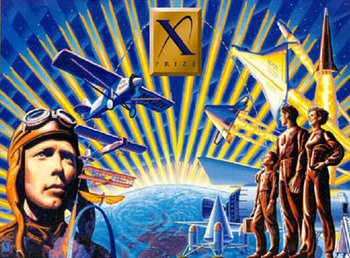The Power of the "Push Prize"
Cash prizes for technology - what I'm calling a "push prize" - is an old idea that's recently come back into favor in a big way. Until recently the most famous of these prizes was the Orteig Prize. Charles Lindberg won this $25,000 prize when he made his famous flight across the Atlantic in 1927.
 The Orteig Prize directly inspired the $10,000,000 Ansari X Prize. The X-prize was awarded last year to the Tier One Program, which flew twice into space with a privately developed spacecraft called SpaceShipOne.
The Orteig Prize directly inspired the $10,000,000 Ansari X Prize. The X-prize was awarded last year to the Tier One Program, which flew twice into space with a privately developed spacecraft called SpaceShipOne.
This year, a team from Stanford University won the $1,000,000 DARPA Grand Challege with their robot-piloted Volkswagen "Stanley." The Defense Department promoted that contest with the ultimate goal of making one-third of ground military forces completely automated by 2015 - thereby lowering the casualty rate from roadside bombs and ambushes in places like Iraq.
And the fund for the Methuselah Mouse Prize just received an anonymous donation of $1,000,000 to conquer aging in mice - prep work for doing the same in people.
Public and private institutions keep returning to the prize model to push breakthrough technologies because it works and it's cheap. Who would have imagined that a mere $10,000,000 could help launch any kind of space program? Apparently the founders of the X-Prize thought so, but the cheap route is hardly the way NASA goes into space.
Or that's what I thought until I learned about NASA's sponsorship of the Space Elevator Games. NASA, it seems, is starting to look beyond rockets to new ways to get into space. This is important because it now costs roughly $2,000,000 to take 200 pounds into orbit atop a rocket. Nobody in the private sector, beside a few billionaire tourists, will be able to properly utilize space at that cost. Space has got to get cheaper - but rockets sufficient to break Earth's gravity will always be expensive.
So NASA is giving serious thought to the Space Elevator. This structure will be exactly what it sounds like - a gentle, slow ride from the surface of the earth into space in a vehicle that will climb a tether. The cost to get a hypothetical 200 pound astronaut into orbit will fall from $2,000,000 to $1,000. This, according to NASA's Space Elevator consultant, Dr. Bradley Edwards.
In 2000 NASA retained Dr. Edwards to do a feasibility study on the Space Elevator. This study showed that the Space Elevator was possible given foreseeable improvements in existing technology. Previously it had been known that a Space Elevator would require a material much stronger than any that existed at that time. This unknown material was often referred to as fictionite or unobtainium.
That changed in 1991 when Japanese researcher Sumio Iijima discovered the carbon nanotube. Theoretically the carbon nanotube could be 100 times the strength of steel at one-fifth of the weight. This is three times stronger than needed for a Space Elevator, but producing nanotube ribbons of sufficient length and strength has continued to be a challenge.
The other major hurdle is producing a practical "climber" vehicle powered by laser light shot up from the base station to the climber. A light-powered climber would not have to lift a heavy load of fuel. This increases the climber's useful lift capacity - more people and materials can be sent up at lower cost.
With these issues in mind the first annual Space Elevator games were held the weekend of October 22, 2005 at NASA's Ames Research Center in Silicon Valley. There were two events: a "tug a war" of sorts, and a "rope climb." Each event had a cash prize of $50,000.
In the "tug-a-war" a machine literally pulled each team's tether until it broke. In order to win a team had to produce a tether that was at least 50% stronger than NASA's previous best tether AND beat all the other teams. While the best tether that day was not quite 50% stronger than NASA's previous best, it was quite a bit stronger. No team won that contest, but NASA now has a better tether.
Teams competing in the "rope climb" event sent light powered climbers up a tether. While none of the teams were able to climb at NASA's minimum meter-per-second pace, they were able to demonstrate that light powered climbers are feasible.
NASA intends to repeat the contest annually with increasing prize amounts as a part of NASA Centennial Prize program.
NASA should be commended for it's willingness to think "outside the box" in several respects. Not only is NASA daring to consider a path to space beyond the traditional rocket, but they are also harnessing the energy and imagination of a new generation of engineers eager to make a name for themselves. Bravo!
And if the mouse prize works out, more of us will live to see this Space Elevator in action.
Comments
The impressive progress in the DARPA Grand Challange shows the power of the push. Last year's best entry made seven miles; this year the pack made it to three times that distance. If they run it again next year, for trophies and sponsor prizes, I would bet that most of the entrants will prove to have debugged the 23 mile point.
Posted by: triticale![[TypeKey Profile Page]](http://www.blog.speculist.com/nav-commenters.gif) |
November 5, 2005 06:32 PM
|
November 5, 2005 06:32 PM